NFT Marketplace on Avalanche
These tutorials were published as a snapshot of when they were written, and may contain out-of-date-information. For up-to-date information, please reach out to the owners of these projects.
Step by step tutorial to build your own NFT marketplace on Avalanche using Hardhat and React.
Table of Contents
- Introduction
- Getting Started
- Contracts for the marketplace
- AVAX Fuji Testnet
- Deploying the contracts
- React App
- Using with other NFT contracts
- Next steps
- Deploying to the Avalanche Mainnet
- Conclusion
Introduction
We will be using React JS to build the frontend of our NFT Marketplace and we will use Ethers to interact with the smart contracts on the frontend. For the backend, we will be using our smart contracts that will be deployed on the Avalanche chain and that's all. Our NFT Marketplace will live on the blockchain. Totally decentralized! We will be using Hardhat to compile and deploy our smart contracts.
Prerequisites
- Basic knowledge of React JS.
- React is a JavaScript library for building user interfaces. React makes it easier to create interactive UIs. The whole UI of the NFT Marketplace is just a single file. You may use anything you would like to build your UI (Angular, Vanilla JS, Vue.js). The important part is to know how to interact with the blockchain and our smart contracts.
- Very basic knowledge of Hardhat.
- Hardhat is a development environment to compile, deploy, test, and debug your solidity code. You may use Truffle or any other framework that lets you deploy smart contracts as well. I do prefer using Hardhat.
- Basic knowledge of Ethers library.
- Basic knowledge of Solidity language.
- We will be writing our smart contracts in solidity. A piece of basic knowledge is required for you to understand the concepts fully.
Requirements
- Node JS and npm must be installed.
- Hardhat must be installed.
- MetaMask extension must be installed on your browser.
- create-react-app must be installed.
Getting Started
Building the Workspace
Let's get started by setting up our workspace using Hardhat.
- Execute
$ npx hardhat initin your working directory. - When you are prompted on the terminal
- Choose
Create a basic sample project. - Add the
.gitignorefile. - Install the dependencies.
- Choose
- Delete the
Greeter.solfile inside the contracts folder.
This will set up our initial workspace.
Creating the NFT Token
First, we need to create an NFT token that will be displayed in our marketplace.
Create a simple ERC-721 token.
contract NFT is ERC721 {
using Counters for Counters.Counter;
Counters.Counter private _tokenIds;
mapping (uint => uint) public itemValue;
uint maxValue = 10000; // Max value of an item
constructor() ERC721("Super NFT", "SPRNFT") {}
/**
Returns a random number
*/
function random() private view returns (uint) {
return uint(keccak256(abi.encodePacked(block.difficulty, block.timestamp, block.number)));
}
function myItems() external view returns (uint[] memory items) {
// Returns an array of items that the user owns
items = new uint[](balanceOf(msg.sender));
uint _counter = 0;
for(uint i = 1; i < _tokenIds.current(); i++) { // i = 1 because the token counter is increased before the id is assigned
if(ownerOf(i) == msg.sender) { // if the user owns the item
items[_counter] = i; // add the item to the array
_counter++; // increase the counter
}
}
return items;
}
function getItem() payable public returns (uint256) {
require(msg.value == 0.5 ether); // 0.5 AVAX is the cost of an item
_tokenIds.increment(); // Increase the counter
uint256 newItemId = _tokenIds.current(); // Get the current counter value
_mint(msg.sender, newItemId); // Mint the new item to the user
itemValue[newItemId] = random() % maxValue; // Set the item value to a random number modulus used to make sure that the value isn't bigger than maxValue
return newItemId; // Return the new item id
}
}
ALERT
Secure random-number generation in the blockchain is a very difficult problem. Our method here is insecure, but since this is just an example, it will be good enough for our purposes.
ALERT
The logic here is very simple.
- User calls the getItem() function and pays 0.5 AVAX
- The value of the token is determined using a random number.
- The token is minted to the user.
And that's all.
Contracts for the Marketplace
We will have two contracts, AuctionManager and Auction contracts.
AuctionManager contract will create the auctions by deploying the Auction
contract using the parameters.
Here is how it will work:
- The auction creator enters parameters for direct buy price, starting price, minimum bid increment, the token id, and the auction end time.
- The auction creator gives approval for the NFT that will be auctioned to the AuctionManager.
- The AuctionManager creates an Auction with the parameters given and then transfers the NFT to the newly created Auction contract.
- After the auction is completed, the auction creator and the auction winner must call the withdrawal functions to retrieve their tokens.
Auction Contract
Starting with the Functions
Our auction contract will allow users to place bids, cancel the auction if there are no bids and withdraw their tokens and funds after the auction has been completed. We will also need a function to get the current state of the auction.
contract Auction {
function placeBid() payable external returns(bool){} // Place a bid on the auction
function withdrawToken() external returns(bool){} // Withdraw the token after the auction is over
function withdrawFunds() external returns(bool){} // Withdraw the funds after the auction is over
function cancelAuction() external returns(bool){} // Cancel the auction
function getAuctionState() public view returns(uint) {} // Get the auction state
function allBids() external view returns (address[] memory, uint256[] memory) {} // Returns a list of all bids and addresses
}
Events
There will be four events in the contract.
NewBid will be emitted each time there is a new bid.
WithdrawToken will be emitted when the highest bidder withdraws the token.
WithdrawFunds will be emitted when the auction owner withdraws the funds.
AuctionCancelled will be emitted when the auction gets canceled.
contract Auction {
event NewBid(address bidder, uint bid); // A new bid was placed
event WithdrawToken(address withdrawer); // The auction winner withdrawed the token
event WithdrawFunds(address withdrawer, uint256 amount); // The auction owner withdrawed the funds
event AuctionCancelled(); // The auction was cancelled
}
Storage Variables
We will need to declare a few variables.
endTimeis the end timestamp of the auction. The auction will end if the current timestamp is equal or greater than theendTime.startTimeis the timestamp that marks the start of the auction.maxBidthe amount of max bid.maxBidderis the address of the max bidder.creatoris the address of the auction creator.bidsarray of bids, we will use this to display recent bids on the web page.tokenIdis the id of the token that has been auctioned.isCancelledwill be true if the auction has been canceled.isDirectBuywill be true if someone placed a bit with a higher or equal value than the direct buy price.minIncrementis the minimum increment for the bid.directBuyPriceis the price for a direct buy.startPriceis the starting price for the auction.nftAddressis the address of the NFT contract_nftis the NFT token.
contract Auction {
uint256 public endTime; // Timestamp of the end of the auction (in seconds)
uint256 public startTime; // The block timestamp which marks the start of the auction
uint maxBid; // The maximum bid
address maxBidder; // The address of the maximum bidder
address creator; // The address of the auction creator
Bid[] public bids; // The bids made by the bidders
uint tokenId; // The id of the token
bool isCancelled; // If the the auction is cancelled
bool isDirectBuy; // True if the auction ended due to direct buy
uint minIncrement; // The minimum increment for the bid
uint directBuyPrice; // The price for a direct buy
uint startPrice; // The starting price for the auction
IERC721 _nft; // The NFT token
enum AuctionState {
OPEN,
CANCELLED,
ENDED,
DIRECT_BUY
}
struct Bid { // A bid on an auction
address sender;
uint256 bid;
}
}
We would be using block numbers instead of timestamps. If we were developing
this application on another chain such as Ethereum Mainnet, block timestamps are
being set by the miners, and they are spoofable. However, in Avalanche, there is
no set block rate; thus, we cannot rely on block numbers. We will be using
block.timestamp to measure time. Timestamps are guaranteed to be within 30
seconds of real-time therefore we do not need to worry about it. Read more
about it
here..
The auction will end when the current timestamp is greater than or equal to the
endTime. endTime is the end timestamp of the auction.
Constructor Function
We will need to get some parameters from the AuctionManager contract.
constructor(address _creator,uint _endTime,uint _minIncrement,uint _directBuyPrice, uint _startPrice,address _nftAddress,uint _tokenId){
creator = _creator; // The address of the auction creator
endTime = block.timestamp + _endTime; // The timestamp which marks the end of the auction (now + 30 days = 30 days from now)
startBlock = block.timestamp; // The timestamp which marks the start of the auction
minIncrement = _minIncrement; // The minimum increment for the bid
directBuyPrice = _directBuyPrice; // The price for a direct buy
startPrice = _startPrice; // The starting price for the auction
_nft = IERC721(_nftAddress); // The address of the nft token
nftAddress = _nftAddress;
tokenId = _tokenId; // The id of the token
maxBidder = _creator; // Setting the maxBidder to auction creator.
}
Building the Functions
Get the Auction State
Let's start with the getAuctionState function as we are going to use it in
other functions. First, we need to check if the auction has been canceled and
return AuctionState.CANCELLED in that case. Then, we need to check if anyone
bid more or equal to the direct buy price and return AuctionState.DIRECT_BUY
in that case. Then, we need to check if the current timestamp is greater or
equal to the endTime and return AuctionState.ENDED in that case. Otherwise,
we will return AuctionState.OPEN.
// Get the auction state
function getAuctionState() public view returns(AuctionState) {
if(isCancelled) return AuctionState.CANCELLED; // If the auction is cancelled return CANCELLED
if(isDirectBuy) return AuctionState.DIRECT_BUY; // If the auction is ended by a direct buy return DIRECT_BUY
if(block.timestamp >= endTime) return AuctionState.ENDED; // The auction is over if the block timestamp is greater than the end timestamp, return ENDED
return AuctionState.OPEN; // Otherwise return OPEN
}
Placing Bids
Let's start building the function for placing bids.
The user calls the placeBid function and sends an amount of AVAX.
Firstly, there are few things we need to check;
- The bidder cannot be the auction creator
- The auction must be open.
- The bid must be greater than the start price.
- The bid must be greater than the highest bid + minimum bid increment.
function placeBid() payable external returns(bool){
require(msg.sender != creator); // The auction creator can not place a bid
require(getAuctionState() == AuctionState.OPEN); // The auction must be open
require(msg.value > startPrice); // The bid must be higher than the starting price
require(msg.value > maxBid + minIncrement); // The bid must be higher than the current bid
}
Next, we will set the new max bid and the max bidder. After that, we will store the value of the last highest bid and the bidder because we will need this information later.
address lastHightestBidder = maxBidder; // The address of the last highest bidder
uint256 lastHighestBid = maxBid; // The last highest bid
maxBid = msg.value; // The new highest bid
maxBidder = msg.sender; // The address of the new highest bidder
Next, we have to check if the bid (msg.value) is greater or equal to the
direct buy price. In that case, we will need to set the isDirectBuy to true;
thus, close the auction.
if(msg.value >= directBuyPrice){ // If the bid is higher or equal to the direct buy price
isDirectBuy = true; // The auction has ended
}
Next, we have to push the value of the new bid into the bids array.
bids.push(Bid(msg.sender,msg.value));
Finally, if there is a previous bid, we have to refund the previous highest bid to the previous bidder. Also, we should emit a NewBid event.
if(lastHighestBid != 0){ // if there is a bid
address(uint160(lastHightestBidder)).transfer(lastHighestBid); // refund the previous bid to the previous highest bidder
}
emit NewBid(msg.sender,msg.value); // emit a new bid event
return true;
Here is the complete function
// Place a bid on the auction
function placeBid() payable external returns(bool){
require(msg.sender != creator); // The auction creator can not place a bid
require(getAuctionState() == AuctionState.OPEN); // The auction must be open
require(msg.value > startPrice); // The bid must be higher than the starting price
require(msg.value > maxBid + minIncrement); // The bid must be higher than the current bid + the minimum increment
address lastHightestBidder = maxBidder; // The address of the last highest bidder
uint256 lastHighestBid = maxBid; // The last highest bid
maxBid = msg.value; // The new highest bid
maxBidder = msg.sender; // The address of the new highest bidder
if(msg.value >= directBuyPrice){ // If the bid is higher than the direct buy price
isDirectBuy = true; // The auction has ended
}
bids.push(Bid(msg.sender,msg.value)); // Add the new bid to the list of bids
if(lastHighestBid != 0){ // if there is a bid
address(uint160(lastHightestBidder)).transfer(lastHighestBid); // refund the previous bid to the previous highest bidder
}
emit NewBid(msg.sender,msg.value); // emit a new bid event
return true; // The bid was placed successfully
}
Cancel Auction
This is a very simple function. If there are no bids and the auction is open, the auction creator should be able to cancel the auction.
function cancelAuction() external returns(bool){ // Cancel the auction
require(msg.sender == creator); // Only the auction creator can cancel the auction
require(getAuctionState() == AuctionState.OPEN); // The auction must be open
require(maxBid == 0); // The auction must not be cancelled if there is a bid
isCancelled = true; // The auction has been cancelled
_nft.transferFrom(address(this), creator, tokenId); // Transfer the NFT token to the auction creator
emit AuctionCanceled(); // Emit Auction Canceled event
return true;
}
Withdraw Token
After the auction has been completed, the highest bidder should be able to
withdraw the NFT token. The msg.sender must be the highest bidder and the
auction must be completed by either direct buy or timeout, otherwise the
function must revert. After that, The NFT with the token id tokenId will be
transferred to the highest bidder.
We've set the max bidder initial value to the auction creator's wallet address, so if the auction times out and no one bids, the auction creator will be able to withdraw the token.
// Withdraw the token after the auction is over
function withdrawToken() external returns(bool){
require(getAuctionState() == AuctionState.ENDED || getAuctionState() == AuctionState.DIRECT_BUY); // The auction must be ended by either a direct buy or timeout
require(msg.sender == maxBidder); // The highest bidder can only withdraw the token
_nft.transferFrom(address(this), maxBidder, tokenId); // Transfer the token to the highest bidder
emit WithdrawToken(maxBidder); // Emit a withdraw token event
}
Withdraw Funds
After the auction has been completed, the auction creator should be able to
withdraw the funds. The msg.sender must be the auction owner and the auction
must be completed by either a direct buy or timeout; otherwise, the function
must revert. After that, the max bid amount must be transferred to the auction
creator.
// Withdraw the funds after the auction is over
function withdrawFunds() external returns(bool){
require(getAuctionState() == AuctionState.ENDED || getAuctionState() == AuctionState.DIRECT_BUY); // The auction must be ended by either a direct buy or timeout
require(msg.sender == creator); // The auction creator can only withdraw the funds
address(uint160(msg.sender)).transfer(maxBid);
emit WithdrawFunds(msg.sender,maxBid); // Emit a withdraw funds event
}
Get All Bids
We will need a function to get a list of all bids and the bidders.
// Returns a list of all bids and addresses
function allBids()
external
view
returns (address[] memory, uint256[] memory)
{
address[] memory addrs = new address[](bids.length);
uint256[] memory bidPrice = new uint256[](bids.length);
for (uint256 i = 0; i < bids.length; i++) {
addrs[i] = bids[i].sender;
bidPrice[i] = bids[i].bid;
}
eturn (addrs, bidPrice);
}
Our Auction contract is ready. Here is the complete code: Auction Contract
Auction Manager Contract
We will use this contract to get a list of all auctions, and to create new ones. Let's start with the basic structure.
pragma solidity ^0.7.0;
import "./Auction.sol";
import "@openzeppelin/contracts/token/ERC721/IERC721.sol";
contract AuctionManager {
uint _auctionIdCounter; // auction Id counter
mapping(uint => Auction) public auctions; // auctions
function createAuction(uint _endTime, uint _minIncrement, uint _directBuyPrice,uint _startPrice,address _nftAddress,uint _tokenId) external returns (bool) {} // create an auction
function getAuctions() external view returns(address[] memory _auctions) {} // Return a list of all auctions
function getAuctionInfo(address[] calldata _auctionsList) external view
returns (
uint256[] memory directBuy,
address[] memory owner,
uint256[] memory highestBid,
uint256[] memory tokenIds,
uint256[] memory endTime,
uint256[] memory startPrice,
uint256[] memory auctionState
) {} // Return the information of each auction address
}
We will need two functions, one for creating an auction and the other one for getting a list of auctions. We will use the counter to assign a unique id for each auction so we can keep track of them.
Building the Functions
Create Auction
This is a very straightforward function.
First, we need to check that:
- Direct buy price is greater than zero.
- Start price is greater than the direct buy price.
- End time is greater than 5 minutes, so no one will be able to create an auction that lasts few seconds. That wouldn't make sense.
require(_directBuyPrice > 0); // direct buy price must be greater than 0
require(_startPrice < _directBuyPrice); // start price is smaller than direct buy price
require(_endTime > 5 minutes); // end time must be greater than 5 minutes (setting it to 5 minutes
Then, we will create a new Auction contract using the parameters and assign an id to it.
uint auctionId = _auctionIdCounter; // get the current value of the counter
_auctionIdCounter++; // increment the counter
Auction auction = new Auction(msg.sender, _endTime, _minIncrement, _directBuyPrice, _startPrice, _nftAddress, _tokenId); // create the auction
Finally, we will transfer the NFT token to the newly generated Auction contract and update our auctions map.
IERC721 _nftToken = IERC721(_nftAddress); // get the nft token
_nftToken.transferFrom(msg.sender, address(auction), _tokenId); // transfer the token to the auction
auctions[auctionId] = auction; // add the auction to the map
return true;
See the complete function.
// create an auction
function createAuction(uint _endTime, uint _minIncrement, uint _directBuyPrice,uint _startPrice,address _nftAddress,uint _tokenId) external returns (bool){
require(_directBuyPrice > 0); // direct buy price must be greater than 0
require(_startPrice < _directBuyPrice); // start price is smaller than direct buy price
require(_endTime > 5 minutes); // end time must be greater than 5 minutes (setting it to 5 minutes for testing you can set it to 1 days or anything you would like)
uint auctionId = _auctionIdCounter; // get the current value of the counter
_auctionIdCounter++; // increment the counter
Auction auction = new Auction(msg.sender, _endTime, _minIncrement, _directBuyPrice, _startPrice, _nftAddress, _tokenId); // create the auction
IERC721 _nftToken = IERC721(_nftAddress); // get the nft token
_nftToken.transferFrom(msg.sender, address(auction), _tokenId); // transfer the token to the auction
auctions[auctionId] = auction; // add the auction to the map
return true;
}
Get Auctions
This function will iterate over all auctions and return a list of auction addresses.
// Return a list of all auctions
function getAuctions() external view returns(address[] memory _auctions) {
_auctions = new address[](_auctionIdCounter); // create an array of size equal to the current value of the counter
for(uint i = 0; i < _auctionIdCounter; i++) { // for each auction
_auctions[i] = address(auctions[i]); // add the address of the auction to the array
}
return _auctions; // return the array
}
Then, we can use this list of auctions to display them on the web page. We will need a function to obtain information about the auctions. Given an array of auction addresses, we would like to get direct buy price, auction creator, starting price, highest bid, token id, auction state, and the end time.
// Return the information of each auction address
function getAuctionInfo(address[] calldata _auctionsList)
external
view
returns (
uint256[] memory directBuy,
address[] memory owner,
uint256[] memory highestBid,
uint256[] memory tokenIds,
uint256[] memory endTime,
uint256[] memory startPrice,
uint256[] memory auctionState
)
{
directBuy = new uint256[](_auctionsList.length); // create an array of size equal to the length of the passed array
owner = new address[](_auctionsList.length); // create an array of size equal to the length of the passed array
highestBid = new uint256[](_auctionsList.length);
tokenIds = new uint256[](_auctionsList.length);
endTime = new uint256[](_auctionsList.length);
startPrice = new uint256[](_auctionsList.length);
auctionState = new uint256[](_auctionsList.length);
for (uint256 i = 0; i < _auctionsList.length; i++) { // for each auction
directBuy[i] = Auction(auctions[i]).directBuyPrice(); // get the direct buy price
owner[i] = Auction(auctions[i]).creator(); // get the owner of the auction
highestBid[i] = Auction(auctions[i]).maxBid(); // get the highest bid
tokenIds[i] = Auction(auctions[i]).tokenId(); // get the token id
endTime[i] = Auction(auctions[i]).endTime(); // get the end time
startPrice[i] = Auction(auctions[i]).startPrice(); // get the start price
auctionState[i] = uint(Auction(auctions[i]).getAuctionState()); // get the auction state
}
return ( // return the arrays
directBuy,
owner,
highestBid,
tokenIds,
endTime,
startPrice,
auctionState
);
}
Here is the complete code: AuctionManager.sol
That's all for the contracts!
AVAX Fuji Testnet
We are going to test the marketplace on AVAX Fuji Testnet. First, you need to
add AVAX Fuji Testnet to MetaMask. Open MetaMask and view networks, then click
on Custom RPC.
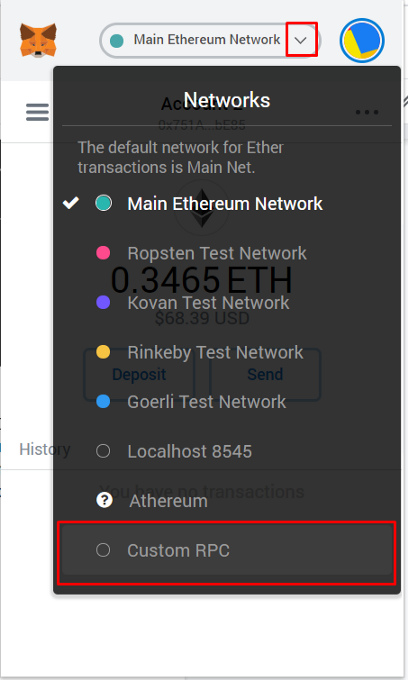
We will deploy our contracts on Fuji Testnet. Fuji Testnet Settings:
- Network Name: Avalanche Fuji C-Chain
- New RPC URL: https://api.avax-test.network/ext/bc/C/rpc
- ChainID: 43113
- Symbol: AVAX
- Explorer: https://testnet.snowtrace.io
Next, we will add the network configuration in hardhat config file
hardhat.config.js. If you do not
know how that file works then take a look at
here.
networks:{
...
fuji: {
url: "https://api.avax-test.network/ext/bc/C/rpc",
chainId: 43113,
accounts: [
"PRIVATE_KEY",
],
},
}
Lastly, we will need some AVAX to deploy our contracts. Use this AVAX Fuji Testnet Faucet to get some test AVAX for free.
Deploying the Contracts
We need to deploy our NFT and AuctionManager contracts to the Fuji Testnet.
We will use hardhat to deploy the contracts, learn more about it
here. Start by editing the
scripts/deploy.js file.
const main = async () => {
const NftToken = await ethers.getContractFactory("NFT"); // NFT token contract
const nftToken = await NftToken.deploy(); // NFT token contract instance
await nftToken.deployed(); // wait for contract to be deployed
const nftTokenAddress = await nftToken.address; // NFT token contract address
const AuctionManager = await ethers.getContractFactory("AuctionManager"); // Auction Manager contract
const auctionManager = await AuctionManager.deploy(); // Auction Manager contract instance
await auctionManager.deployed(); // wait for contract to be deployed
const auctionManagerAddress = await auctionManager.address; // Auction Manager contract address
console.log(`NFT deployed to: ${nftTokenAddress}`); // NFT token contract address
console.log(`Auction Manager deployed to: ${auctionManagerAddress}`); // Auction Manager contract address
};
main()
.then(() => process.exit(0))
.catch((error) => {
console.error(error);
process.exit(1);
});
After you are done editing
deploy.js, execute the following
lines on your terminal to run the
deploy.js script.
npx hardhat compile # Compiles the contracts
npx hardhat run scripts/deploy.js --network fuji # runs the "deploy.js" script on fuji test network, "fuji" is specified inside the hardhat config file
Pretty simple! If this looks unfamiliar to you, you may want to take a look at hardhat guides.
Do not forget to note the addresses, as we will need them afterward to interact with the contracts.

React App
Let's build an interface to interact with our marketplace. We are going to use react and ether.js.
Execute the following lines on your terminal to get started.
create-react-app frontend # creates a react app inside the frontend folder
cd frontend # go inside the frontend folder
npm install --save ethers # install ethers package
npm run start # start the react app
Add bootstrap CDN in the head section of
public/index.html
file. We will use bootstrap to speed up.
<head>
...
+ <link
+ rel="stylesheet"
+ href="https://stackpath.bootstrapcdn.com/bootstrap/4.4.1/css/bootstrap.min.css"
+ />
</head>
...
</body>
+ <script src="https://code.jquery.com/jquery-3.4.1.slim.min.js"></script>
+ <script src="https://cdn.jsdelivr.net/npm/[email protected]/dist/umd/popper.min.js"></script>
+ <script src="https://stackpath.bootstrapcdn.com/bootstrap/4.4.1/js/bootstrap.min.js"></script>
</html>
Start with a fresh App.js file.
Import the ethers library and assign the contract addresses to constant
strings.
Since there aren't any auctions yet, we need to create one first. However, before creating an auction, we need to mint an NFT.
import React from "react";
import { ethers } from "ethers";
const NFT_ADDRESS = "0xeb2283672cf716fF6A1d880436D3a9074Ba94375"; // NFT contract address
const AUCTIONMANAGER_ADDRESS = "0xea4b168866E439Db4A5183Dbcb4951DCb5437f1E"; // AuctionManager contract address
class App extends React.Component {
constructor(props) {
super(props);
this.state = {
auctions: [], // Auctions to display
newAuction: {
// newAuction is a state variable for the form
startPrice: null,
endTime: null,
tokenId: null,
minIncrement: null,
directBuyPrice: null,
},
myItems: [],
};
}
render() {
return (
<div>
<div class="jumbotron d-flex align-items-center">
<div class="container">
<div class="auctions row"></div>
</div>
</div>
<div class="container">
<form>
<button type="submit" class="btn btn-primary">
Create Auction
</button>
</form>
<button class="btn btn-fanger">Mint NFT</button>
<p>
Your items
<br />
{(this.state.myItems || [""]).map((x) => `id: ${x} `) || ""}
</p>
</div>
</div>
);
}
}
export default App;
Building the Form
We need to add few elements to our form. The user has to type in the start price, token id, minimum increment, how many minutes the auction will last and the direct buy price.
<form>
<div class="mb-3">
<label for="startprice" class="form-label">
Start Price
</label>
<input
value={this.state.newAuction.startPrice}
onChange={(e) =>
this.setState({
newAuction: {
...this.state.newAuction,
startPrice: parseInt(e.target.value),
},
})
}
type="number"
class="form-control"
id="startprice"
/>
<label for="startprice" class="form-label">
Token Id
</label>
<input
value={this.state.newAuction.tokenId}
onChange={(e) =>
this.setState({
newAuction: {
...this.state.newAuction,
tokenId: parseInt(e.target.value),
},
})
}
type="number"
class="form-control"
id="startprice"
/>
<label class="form-label">Minimum Increment</label>
<input
value={this.state.newAuction.minIncrement}
onChange={(e) =>
this.setState({
newAuction: {
...this.state.newAuction,
minIncrement: parseInt(e.target.value),
},
})
}
type="number"
class="form-control"
/>
<label class="form-label">Direct Buy Price</label>
<input
value={this.state.newAuction.directBuyPrice}
onChange={(e) =>
this.setState({
newAuction: {
...this.state.newAuction,
directBuyPrice: parseInt(e.target.value),
},
})
}
type="number"
class="form-control"
/>
<label class="form-label">Duration In Minutes</label>
<input
value={this.state.newAuction.endTime}
onChange={(e) =>
this.setState({
newAuction: {
...this.state.newAuction,
endTime: parseInt(e.target.value),
},
})
}
type="number"
class="form-control"
/>
</div>
<button
type="button"
onClick={() => console.log(this.state.newAuction)}
class="btn btn-primary"
>
Create Auction
</button>
</form>
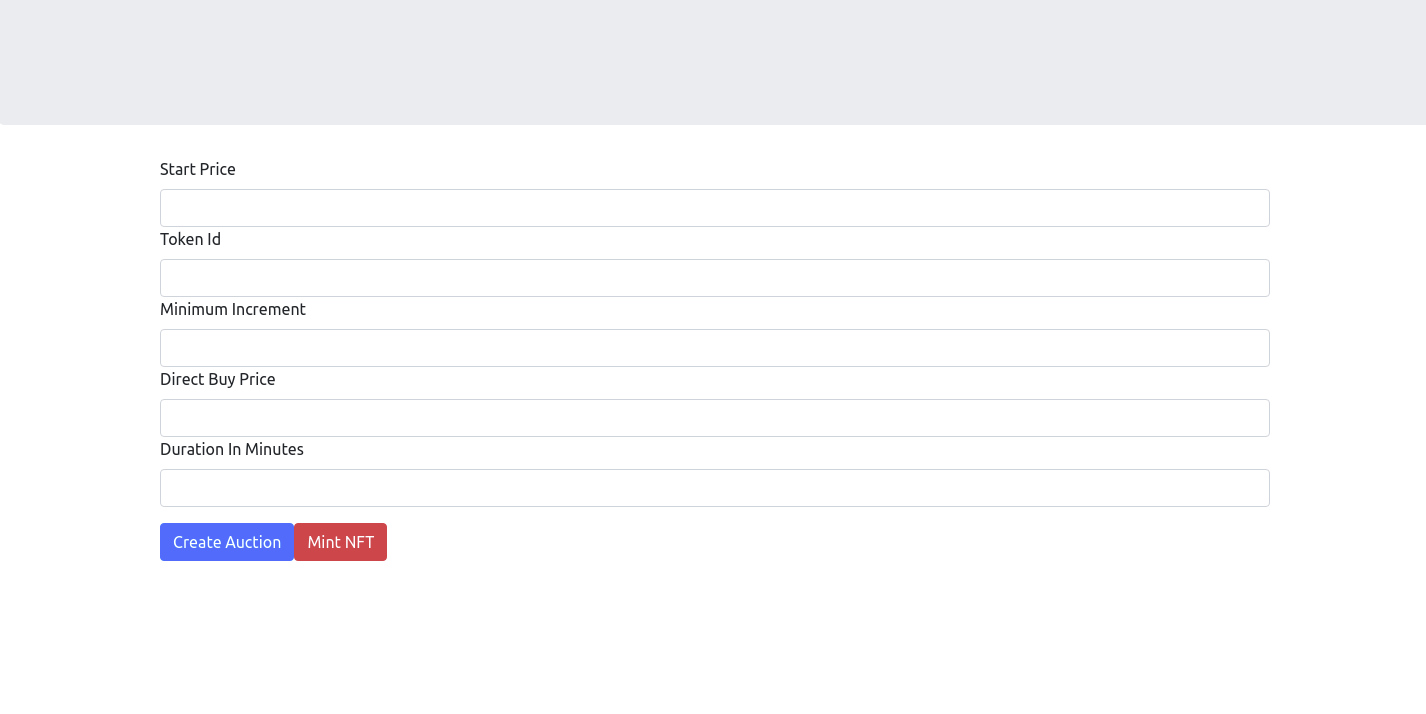
Our form is ready! Let's see how we are going to interact with the contracts.
Interacting with Contracts
Contract ABIs
We will use Contract Application Binary Interface (ABI) to interact with the
contracts. It is the standard way to do it. You can find the ABI of the
compiled contracts in artifacts/contracts/ContractName/ContractName.json file.
Create a frontend/src/artifacts folder and move all those json files there
to reach them easier within the React code.
If you can not find the json files try running npx hardhat compile on your terminal
mkdir frontend/src/artifacts # creates a folder named "artifacts" inside the "src" folder of your React app
mv artifacts/contracts/Auction.sol/Auction.json frontend/src/artifacts/Auction.json # Moves Auction.json to the newly created folder.
mv artifacts/contracts/NFT.sol/NFT.json frontend/src/artifacts/NFT.json # Moves NFT.json to the newly created folder.
mv artifacts/contracts/AuctionManager.sol/AuctionManager.json frontend/src/artifacts/AuctionManager.json # Moves AuctionManager.json to the newly created folder.
Import them in the React code at the top of App.js.
import AuctionArtifact from "./artifacts/Auction.json";
import AuctionManagerArtifact from "./artifacts/AuctionManager.json";
import NFTArtifact from "./artifacts/NFT.json";
Detecting and Connecting to MetaMask
Add an init function which we will call when the page is loaded.
class App extends React.Component {
async init(){}
...
}
We will use Ethers to connect our MetaMask wallet
and call the init function on componentDidMount.
class App extends React.Component {
...
async init() {
if (window.ethereum) {
await window.ethereum.enable(); // Enable the Ethereum client
this.provider = new ethers.providers.Web3Provider(window.ethereum); // A connection to the Ethereum network
this.signer = this.provider.getSigner(); // Holds your private key and can sign things
this.setState({ currentAddress: this.signer.getAddress() }); // Set the current address
this._auctionManager = new ethers.Contract( // We will use this to interact with the AuctionManager
AUCTIONMANAGER_ADDRESS,
AuctionManagerArtifact.abi,
this.signer
);
this._nft = new ethers.Contract( // We will use this to interact with the NFT contract
NFT_ADDRESS,
NFTArtifact.abi,
this.signer
);
} else {
alert("No wallet detected");
}
}
componentDidMount() {
this.init();
}
...
}
Inside the init function we are creating instances of the signer, auction manager contract and our NFT contract. We will use them later.
Take a look at here to learn more about Ethers. Refresh the page now, MetaMask should prompt you to connect your account.
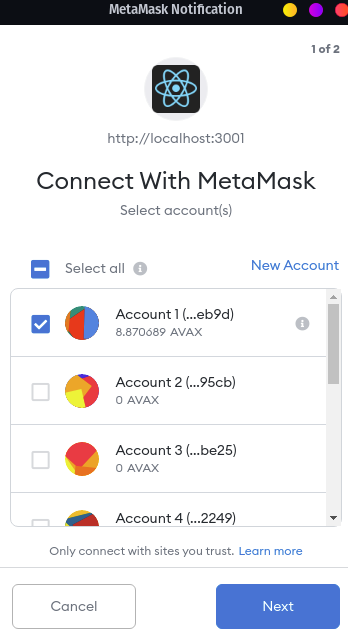
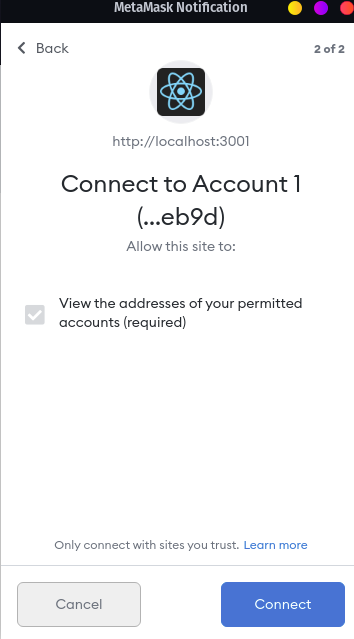
Choose your account and continue. Congrats! We have connected MetaMask to our website.
Minting an NFT
Let's build the mint function, which we will call when the Mint NFT button is pressed.
We are going to use the this.nft object which we created inside the init
function earlier. There is a function named getItem() inside our NFT contract.
We have to call it and pass 0.5 AVAX to mint an NFT.
async mint() {
// hash is the hash of the transaction
let { hash } = await this._nft.getItem({
// Calling the getItem function of the contract
value: ethers.utils.parseEther("0.5"), // 0.5 AVAX
});
console.log("Transaction sent! Hash:", hash);
await this.provider.waitForTransaction(hash); // Wait till the transaction is mined
console.log("Transaction mined!");
alert(`Transaction sent! Hash: ${hash}`);
}
Call this function when the button is pressed.
<button type="button" onClick={() => this.mint()} class="btn btn-danger">
Mint NFT
</button>
Then click the Mint NFT button on the web page.
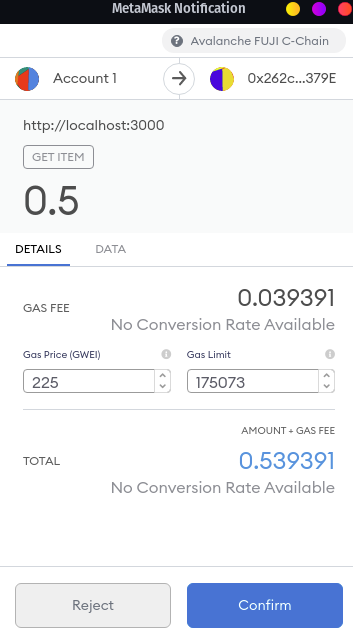
Confirm the transaction. After a few seconds the transaction should get mined.
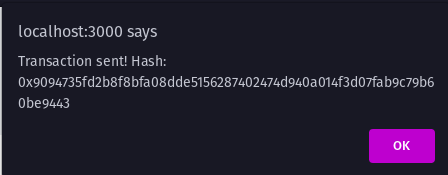
Congrats! We have just minted ourselves an NFT token! I will mint myself two more. You can do as many as you want!
Owned NFT's
We will use the myItems function in the NFT contract to retrieve a list of tokens that we own.
async getItems() {
let items = await this._nft.myItems(); // Get the tokens owned by the user
console.log(items);
}
Call this function at the end of the init() function, so each time the wallet
is connected, we will retrieve the list of items owned by that wallet.
async init() {
if (window.ethereum) {
// if window.ethereum is defined
await window.ethereum.enable(); // Enable the Ethereum client
this.provider = new ethers.providers.Web3Provider(window.ethereum); // A connection to the Ethereum network
this.signer = this.provider.getSigner(); // Holds your private key and can sign things
this._auctionManager = new ethers.Contract( // We will use this to interact with the AuctionManager
AUCTIONMANAGER_ADDRESS,
AuctionManagerArtifact.abi,
this.signer
);
this._nft = new ethers.Contract( // We will use this to interact with the NFT
NFT_ADDRESS,
NFTArtifact.abi,
this.signer
);
+ this.getItems();
} else {
alert("No wallet detected"); // No wallet detected
}
}
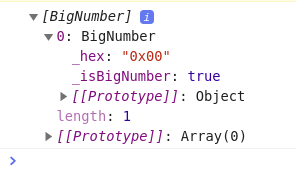
If you reload the page and take a look at the developer console, you may notice
that the array contains values in BigNumber format. We have to convert them to
normal numbers.
async getItems() {
let items = await this._nft.myItems(); // Get the tokens owned by the user
items = items.map((x) => x.toNumber()); // Converts BigNumber to number for each item in array
this.setState({ myItems: items });
}
Now refresh the page.
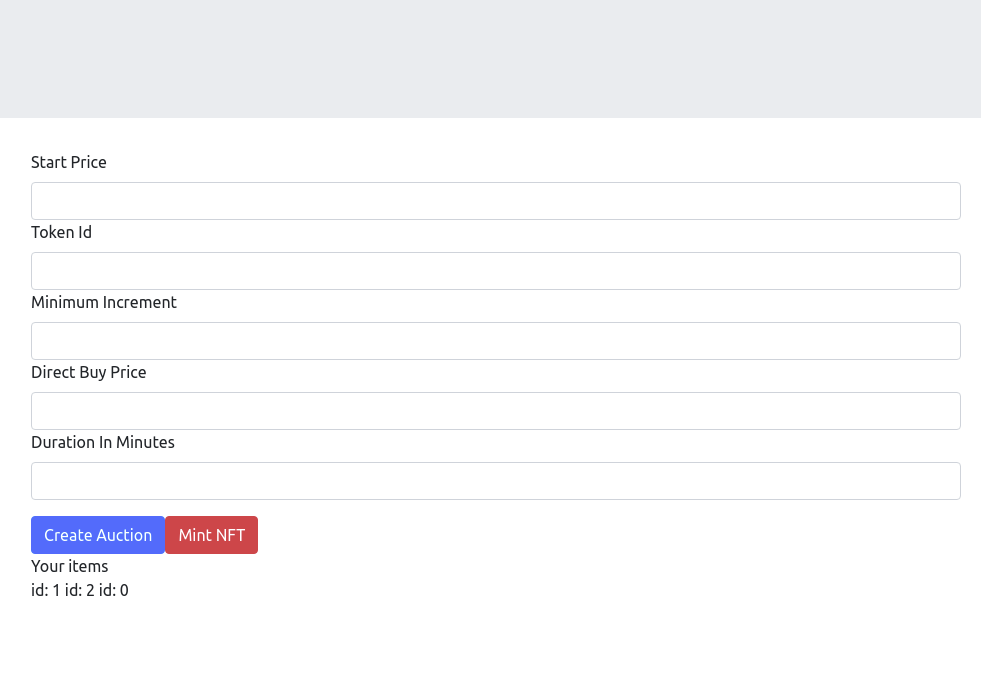
Here they are! I can see all the NFT's I've minted.
Creating an Auction
So far, so good! Let's build a function for creating auctions.
Before calling the createAuction function in the auction manager, first, we
have to give approval for the token that we are going to auction. Giving
approval to the auction manager will let the auction manager transfer our token
to the newly created auction contract.
Here are the steps.
- Check if there are any empty text fields.
if (
!this.state.newAuction.minIncrement ||
!this.state.newAuction.directBuyPrice ||
!this.state.newAuction.startPrice ||
!this.state.newAuction.endTime ||
!this.state.newAuction.tokenId
)
return alert("Fill all the fields");
- We call the
approvefunction of the NFT contract to approve theAuctionManagercontract to transfer the NFT token that we are going to put up for auction.
let { hash: allowance_hash } = await this._nft.approve(
AUCTIONMANAGER_ADDRESS,
this.state.newAuction.tokenId
); // Approve the AUCTIONMANAGER to transfer the token
console.log("Approve Transaction sent! Hash:", allowance_hash);
await this.provider.waitForTransaction(allowance_hash); // Wait till the transaction is mined
console.log("Transaction mined!");
- Then, we will call the
createAuctionfunction in theAuctionManagercontract.
let { hash } = await this._auctionManager.createAuction(
this.state.newAuction.endTime * 60, // Converting minutes to seconds
ethers.utils.parseEther(this.state.newAuction.minIncrement.toString()), // Minimum increment in AVAX
ethers.utils.parseEther(this.state.newAuction.directBuyPrice.toString()), // Direct buy price in AVAX
ethers.utils.parseEther(this.state.newAuction.startPrice.toString()), // Start price in AVAX
NFT_ADDRESS, // The address of the NFT token
this.state.newAuction.tokenId // The id of the token
);
console.log("Transaction sent! Hash:", hash);
await this.provider.waitForTransaction(hash); // Wait till the transaction is mined
console.log("Transaction mined!");
alert(`Transaction sent! Hash: ${hash}`);
Final function
async createAuction() {
if (
!this.state.newAuction.minIncrement ||
!this.state.newAuction.directBuyPrice ||
!this.state.newAuction.startPrice ||
!this.state.newAuction.endTime ||
!this.state.newAuction.tokenId
)
return alert("Fill all the fields");
let { hash: allowance_hash } = await this._nft.approve(
AUCTIONMANAGER_ADDRESS,
this.state.newAuction.tokenId
); // Approve the AUCTIONMANAGER to transfer the token
console.log("Approve Transaction sent! Hash:", allowance_hash);
await this.provider.waitForTransaction(allowance_hash); // Wait till the transaction is mined
console.log("Transaction mined!");
let { hash } = await this._auctionManager.createAuction(
// Create an auction
this.state.newAuction.endTime * 60, // Converting minutes to seconds
ethers.utils.parseEther(this.state.newAuction.minIncrement.toString()), // Minimum increment in AVAX
ethers.utils.parseEther(this.state.newAuction.directBuyPrice.toString()), // Direct buy price in AVAX
ethers.utils.parseEther(this.state.newAuction.startPrice.toString()), // Start price in AVAX
NFT_ADDRESS, // The address of the NFT token
this.state.newAuction.tokenId // The id of the token
);
console.log("Transaction sent! Hash:", hash);
await this.provider.waitForTransaction(hash); // Wait till the transaction is mined
console.log("Transaction mined!");
alert(`Transaction sent! Hash: ${hash}`);
}
Call this function when the Create Auction button is pressed.
...
<button
type="button"
+ onClick={() => this.createAuction()}
class="btn btn-primary"
>
Create Auction
</button>
...
We are ready to start our first auction! Fill the form and press on Create Auction button.
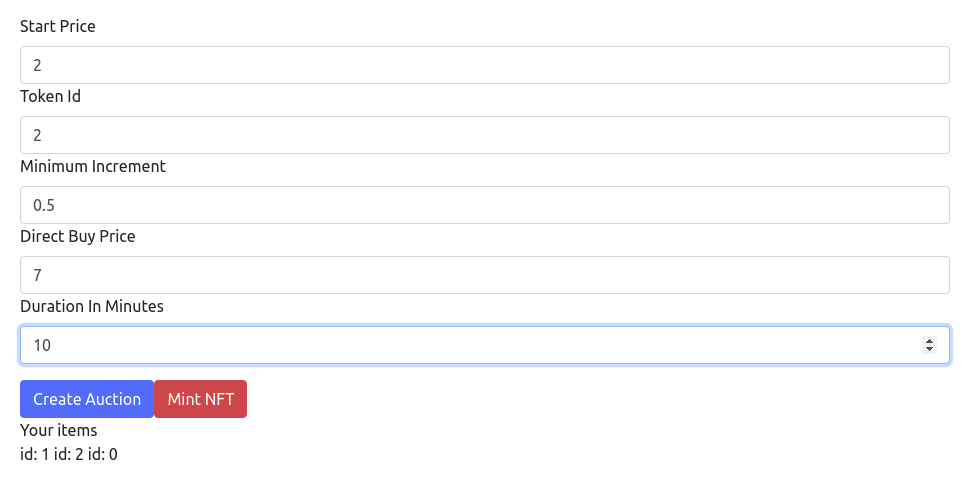
Approve the auction manager contract to transfer the NFT token with ID 2.
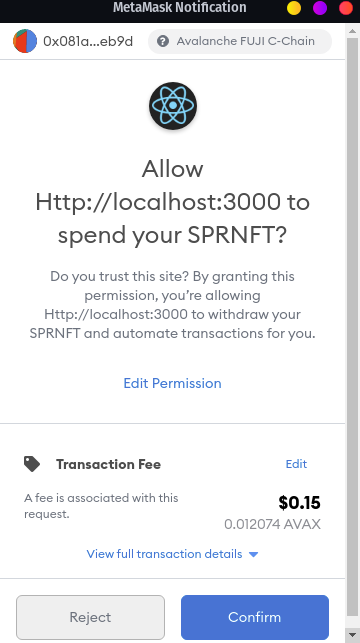
Start the auction!
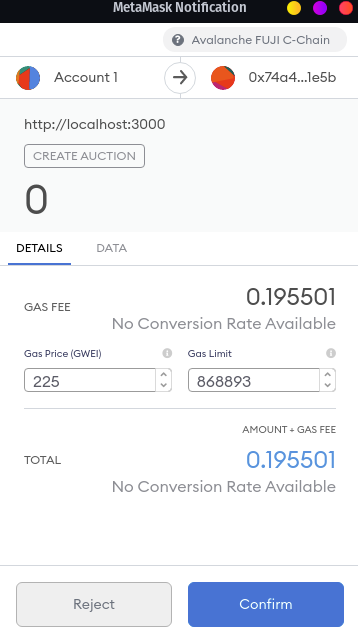
That's it, we have just started our first auction on our NFT marketplace.
Getting the List of Auctions
Let's build a function to get a list of all auctions.
We will use two functions from our AuctionManager contract to achieve this, getAuctions() and getAuctionInfo().
By calling the getAuctions() function, we will get a list of contract
addresses of all the auctions on the marketplace. Next, we will call the
getAuctionInfo() function and pass an array of auction addresses that we would
like to obtain information.
async getAuctions() {
let auctionsAddresses = await this._auctionManager.getAuctions(); // get a list of auction addresses
let auctions = await this._auctionManager.getAuctionInfo(auctionsAddresses); // I'll just pass all the addresses here, you can build a pagination system if you want
console.log("Auctions:", auctions);
this.setState({ auctions }); // Update the state
}
We should call this function at the end of the init() function.
...
this._nft = new ethers.Contract(NFT_ADDRESS, NFTArtifact.abi, this.signer); // We will use this to interact with the NFT
this.getItems();
+ this.getAuctions();
...
Now, take a look at the developer console logs.
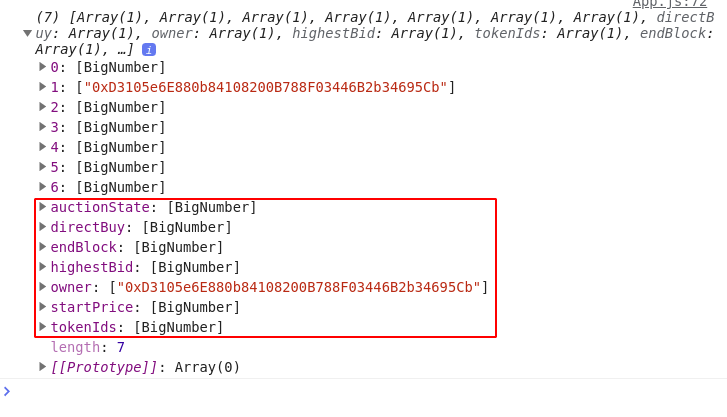
The numbers are again in big number format. We can convert the tokenId and
endTime using .toNumber() method; however, for the BigNumbers that
represent a price, we should use ethers.utils.formatEther to get the exact
value in AVAX.
We should organize the auction array and display them in the auctions section of the web page.
let new_auctions = [];
for (let i = 0; i < auctions.endTime.length; i++) {
let endTime = auctions.endTime[i].toNumber();
let tokenId = auctions.tokenIds[i].toNumber();
let auctionState = auctions.auctionState[i].toNumber();
let startPrice = ethers.utils.formatEther(auctions.startPrice[i]);
let directBuyPrice = ethers.utils.formatEther(auctions.directBuy[i]);
let highestBid = ethers.utils.formatEther(auctions.highestBid[i]);
let owner = auctions.owner[i];
let newAuction = {
endTime: endTime,
startPrice: startPrice,
owner: owner,
directBuyPrice: directBuyPrice,
tokenId: tokenId,
highestBid: highestBid,
auctionState: auctionState,
auctionAddress: auctionsAddresses[i],
};
new_auctions.push(newAuction);
}
this.setState({ auctions: new_auctions }); // Update the state
Now we will write a function to display an auction on the UI.
renderAuctionElement(auction) {
let state = "";
if (auction.auctionState === 0) {
state = "Open";
}
if (auction.auctionState === 1) {
state = "Cancelled";
}
if (auction.auctionState === 2) {
state = "Ended";
}
if (auction.auctionState === 3) {
state = "Direct Buy";
}
return (
<div style={{ background: "yellow" }} class="col">
<p>ID: {auction.tokenId}</p> {/* ID of the token */}
<p>Highest Bid: {auction.highestBid || 0}</p>
{/* Highest bid */}
<p>Direct Buy: {auction.directBuyPrice}</p> {/* Direct buy price */}
<p>Starting Price: {auction.startPrice}</p> {/* Starting price */}
<p>Owner: {auction.owner}</p> {/* Owner of the token */}
<p>
End Time: {Math.round((auction.endTime * 1000 - Date.now()) / 1000 / 60)}{" "}
{/* Time left in minutes */}
minutes
</p>
<p>Auction State: {state}</p>
<button class="btn-primary">See More</button>
</div>
);
}
We have converted the auction.endTime, which is in seconds, to milliseconds by
multiplying by 1000. Then, we have subtracted the result from Date.now(),
which is in milliseconds. After that, we divided the result by 1000 to convert
it to seconds. Finally, we divided it by 60 to convert it to minutes.
Next, we will map all the auctions into the function in our render method.
render() {
return (
<div class="jumbotron d-flex align-items-center">
<div class="container">
<div class="auctions row">
{this.state.auctions.map(this.renderAuctionElement)}
</div>
</div>
</div>
)
}
Let's see the result!

Awesome! There is the auction we've just created.
Building the Auction Page
We'll use a state variable this.state.activeAuction to display the current
auction. We will set this variable when the See More button is pressed. If
this variable is not null, the auction information will be rendered instead of
the list of auctions. We will set this variable back to null by using a go-back
button.
This is not a good practice to do it this way, you should probably use React Navigation, but since this is just a demo, we are doing it this way.
Add a new setActiveAuction function
setActiveAuction(auction) {
this.setState({ activeAuction: auction });
}
It will call the function when the button is pressed.
...
<p>Auction State: {state}</p>
<button class="btn-primary" onClick={() => this.setActiveAuction(auction)}>See More</button>
</div>
...
We would like to display the previous bids for a specific auction. Let's fetch
that data when the setActiveAuction is called.
async setActiveAuction(auction) {
this._auction = new ethers.Contract( // Create a new instance of the contract
auction.auctionAddress,
AuctionArtifact.abi,
this.signer
);
let previousBids = await this._auction.allBids(); // Get the bids
let bids = []; // A list of bids
for (let i = 0; i < previousBids[0].length; i++) { // Loop through the bids
bids.push({ // Add the bid to the list
bidder: previousBids[0][i], // The bidder
bid: ethers.utils.formatEther(previousBids[1][i]), // The bid
});
}
auction.bids = bids; // Add the bids array to the auction object
this.setState({ activeAuction: auction }); // Update the state
}
Later, we will use the this._auction to interact with the auction contract.
That's why we have made it accessible from this.
Do you remember that we have assigned a random value to every minted NFT? Let's also display that value on the auction page.
let auctionTokenValue = await this._nft.itemValue(auction.tokenId); // Get the value of the token
auctionTokenValue = auctionTokenValue.toNumber(); // Convert BigNumber to number
auction.auctionTokenValue = auctionTokenValue; // Add the value of the token to the auction object
We should also know who is the highest bidder.
let highestBidder = await this._auction.maxBidder(); // Get the highest bidder
auction.highestBidder = highestBidder; // Add the highest bidder to the auction object
Lastly, the minimum increment value.
let minIncrement = await this._auction.minIncrement(); // Get the minimum increment
auction.minIncrement = ethers.utils.formatEther(minIncrement); // Add the minimum increment to the auction object
Here is the complete function.
async setActiveAuction(auction) {
console.log(auction);
this._auction = new ethers.Contract( // Create a new instance of the contract
auction.auctionAddress,
AuctionArtifact.abi,
this.signer
);
let previousBids = await this._auction.allBids(); // Get the bids
let bids = []; // A list of bids
for (let i = 0; i < previousBids[0].length; i++) {
// Loop through the bids
bids.push({
// Add the bid to the list
bidder: previousBids[0][i], // The bidder
bid: ethers.utils.formatEther(previousBids[1][i]), // The bid
});
}
auction.bids = bids; // Add the bids array to the auction object
let auctionTokenValue = await this._nft.itemValue(auction.tokenId); // Get the value of the token
auctionTokenValue = auctionTokenValue.toNumber(); // Convert BigNumber to number
auction.auctionTokenValue = auctionTokenValue; // Add the value of the token to the auction object
let highestBidder = await this._auction.maxBidder(); // Get the highest bidder
auction.highestBidder = highestBidder; // Add the highest bidder to the auction object
let minIncrement = await this._auction.minIncrement(); // Get the minimum increment
auction.minIncrement = ethers.utils.formatEther(minIncrement); // Add the minimum increment to the auction object
this.setState({ activeAuction: auction }); // Update the state
}
Rendering the Selected Auction
We will write a simple render function for the selected auction.
renderActiveAuction() {
let activeAuction = this.state.activeAuction;
let state = "";
if (activeAuction.auctionState === 0) { // If the auction is open
state = "Open";
}
if (activeAuction.auctionState === 1) { // If the auction is cancelled
state = "Cancelled";
}
if (activeAuction.auctionState === 2) { // If the auction is ended
state = "Ended";
}
if (activeAuction.auctionState === 3) { // If the auction is ended by a direct buy
state = "Direct Buy";
}
return (
<div>
<div class="col">
<button
class="btn-secondary"
onClick={() => this.setState({ activeAuction: null })}
>
Go Back
</button>
<p>ID: {activeAuction.tokenId}</p> {/* ID of the token */}
<p>Highest Bid: {activeAuction.highestBid || 0} AVAX</p>
{/* Highest bid */}
<p>Direct Buy: {activeAuction.directBuyPrice} AVAX</p>{" "}
{/* Direct buy price */}
<p>Minimum Increment: {activeAuction.minIncrement} AVAX</p>{" "}
{/* Minimum increment in AVAX */}
<p>Starting Price: {activeAuction.startPrice} AVAX</p> {/* Starting price */}
<p>Owner: {activeAuction.owner}</p> {/* Owner of the token */}
<p>
End Time:{" "}
{Math.round(
(activeAuction.endTime * 1000 - Date.now()) / 1000 / 60
)}{" "}
{/* Time left in minutes */}
minutes
</p>
<p>Auction State: {state}</p>
</div>
<div class="col">
<h3>Bids</h3>
<table class="table">
<thead>
<tr>
<th>Bidder</th>
<th>Bid</th>
</tr>
</thead>
<tbody>
{activeAuction.bids.map((bid) => {
return (
<tr key={bid.bidder}>
<td>{bid.bidder}</td>
<td>{bid.bid} AVAX</td>
</tr>
);
})}
</tbody>
</table>
</div>
<div class="col">
<div>
<input type="number" placeholder="0.5" />
<button class="btn-primary">Place Pid</button>
</div>
<button class="btn-danger">Cancel Auction</button>
<button class="btn-secondary">Withdraw Funds</button>
<button class="btn-secondary">Withdraw Token</button>
</div>
</div>
);
}
If this.state.activeAuction is not null, then we will return this function instead of the list of auctions.
Edit the render function
...
<div class="container">
{this.state.activeAuction != null ? (
this.renderActiveAuction()
) : (
<div class="auctions row">
{this.state.auctions.map(this.renderAuctionElement)}
</div>
)}
</div>
...
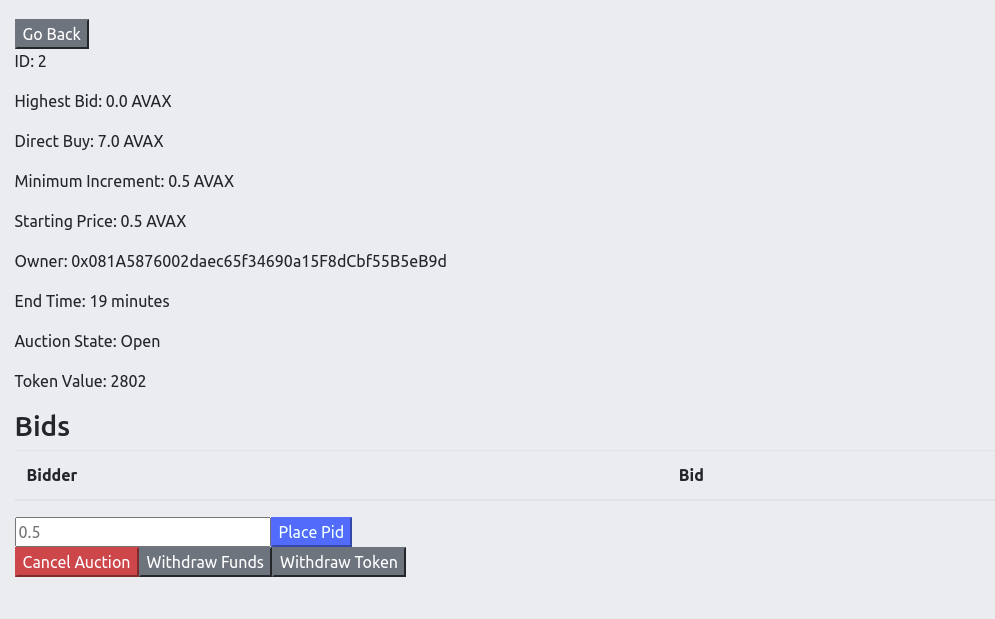
Now, we will have to make those buttons at the bottom functional. Let's write a function for each one!
Auction Functions
Remember the this._auction object we've set inside the setActiveAuction
function? We will use that object to build our functions.
Placing Bids
We will simply call the placeBid function of the Auction contract and pass some AVAX.
async placeBid(amount) {
if (!amount) return;
amount = ethers.utils.parseEther(amount.toString()); // Amount in AVAX
let { hash } = await this._auction.placeBid({ value: amount }); // Place a bid
await this.provider.waitForTransaction(hash); // Wait till the transaction is mined
alert(`Transaction sent! Hash: ${hash}`); // Show the transaction hash
this.setActiveAuction(this.state.activeAuction); // Update the active auction
}
Next, call this function when the button is pressed.
...
<div>
<input
type="number"
placeholder="0.5"
onChange={(e) => this.setState({ bidAmount: e.target.value })}
/>
<button
class="btn-primary"
onClick={() => this.placeBid(this.state.bidAmount)}
>
Place Pid
</button>
</div>
...
Before placing a bid, we must switch to another account on MetaMask since the auction creator cannot place bids. Do not forget to connect the account to the 1537dapp when you switch your account.
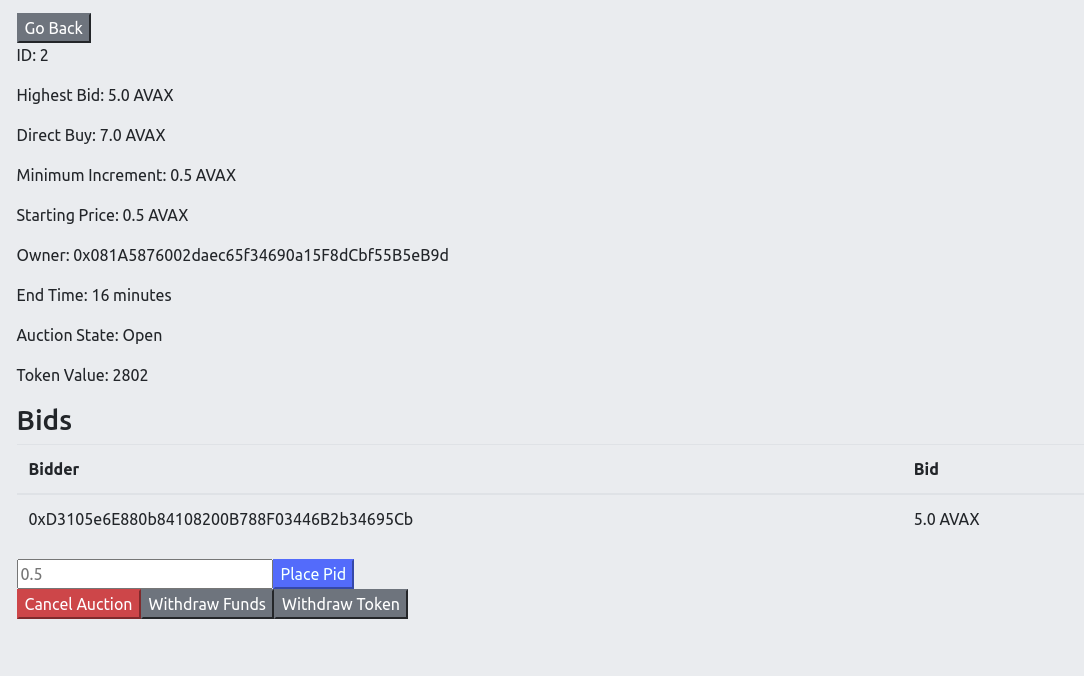
We've placed a bid on the auction! Now let's wait a bit until the auction is over, then we can withdraw our new token if no one bids a higher value.
Withdraw Token
Simply call the withdrawToken function of the Auction contract and show an
alert when the transaction gets mined.
async withdrawToken() {
let { hash } = await this._auction.withdrawToken(); // Withdraw the NFT token
await this.provider.waitForTransaction(hash); // Wait till the transaction is mined
alert(`Withdrawal Successful! Hash: ${hash}`); // Show the transaction hash
window.location.reload(); // Reload the page
}
Call this function when the Withdraw Token button is pressed.
...
<button onClick={()=>this.withdrawToken()} class="btn-secondary">Withdraw Token</button>
...

After some time, the auction is finally over, and our bid is still the highest one. Let's withdraw our new NFT token. Note: It would be nice to hide the end time when the auction is not open.
Approving the transaction...

Refresh the page and we just got our new NFT!
Withdraw Funds
Simply call the withdrawFunds function of the Auction contract and show an
alert when the transaction gets mined.
async withdrawFunds() {
let { hash } = await this._auction.withdrawFunds(); // Withdraw the funds
await this.provider.waitForTransaction(hash); // Wait till the transaction is mined
alert(`Withdrawal Successful! Hash: ${hash}`); // Show the transaction hash
window.location.reload(); // Reload the page
}
Call this function when the Withdraw Funds button is pressed.
...
<button onClick={()=>this.withdrawFunds()} class="btn-secondary">Withdraw Funds</button>
...
Since the auction is already over, we can switch back to the account in which we created the auction and withdraw our funds.
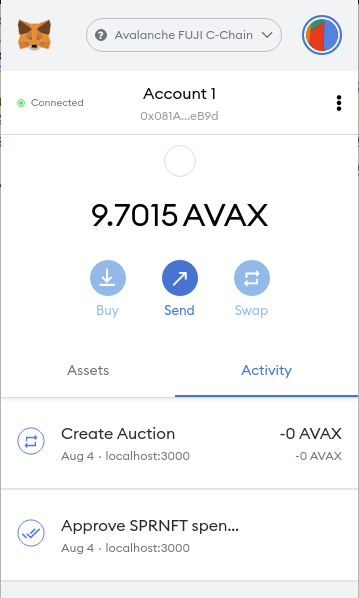
Then we will click on the Withdraw Funds button and confirm the transaction.
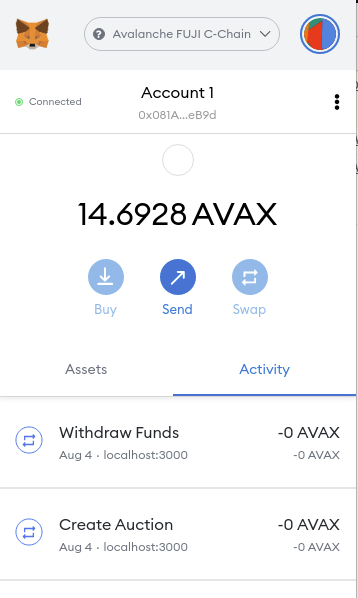
Awesome! We have just sold an NFT and earned some AVAX.
Cancel Auction
Simply call the cancelAuction function of the Auction contract and show an
alert when the transaction gets mined.
async cancelAuction() {
let { hash } = await this._auction.cancelAuction(); // Cancel the auction
await this.provider.waitForTransaction(hash); // Wait till the transaction is mined
alert(`Auction Canceled! Hash: ${hash}`); // Show the transaction hash
window.location.reload(); // Reload the page
}
Call this function when the Cancel Auction button is pressed.
...
<button onClick={() => this.cancelAuction()} class="btn-danger">
Cancel Auction
</button>
...
We have to create a new auction to demonstrate this since we cannot cancel an
auction that has been bid already. Create a new auction, click on the Cancel Auction button and confirm the transaction.
After refreshing the page, we can see that the auction has been canceled.

We can also see that the token was sent back to use after we've canceled the auction.
Polishing the Buttons
If the button is not functional we should hide it. For instance, the Withdraw Funds button is visible to all users; however, only the auction creator can
call it when the auction is over. Thus, we must only make it visible if the
auction is over and the user is the auction creator.
We will do some checks for each button and hide the button if the user is not able to call the function.
Please note that our contract already blocks the other users from calling
Withdraw Funds function. Someone can call any external function of a contract,
even if it's hidden on the web page. It is crucial to make the checks within the
contract code.
We will use some booleans to make this easier.
renderActiveAuction() {
let activeAuction = this.state.activeAuction;
let isOwner = this.state.currentAddress === activeAuction.owner; // Check if the current address is the owner
let isAuctionOpen = state === "Open"; // Check if the auction is open
let isAuctionCancelled = state === "Cancelled"; // Check if the auction is cancelled
let isAuctionEnded = state === "Ended" || state === "Direct Buy"; // Check if the auction is ended
...
}
Place Bid Area
- Auction must be open.
- The auction creator cannot bid.
{
isAuctionOpen && !isOwner ? (
<div>
<input
type="number"
placeholder="0.5"
onChange={(e) => this.setState({ bidAmount: e.target.value })}
/>
<button
class="btn-primary"
onClick={() => this.placeBid(this.state.bidAmount)}
>
Place Pid
</button>
</div>
) : null;
}
Cancel Auction Button
- There must be no bids.
- Auction must be open.
- The caller must be the auction creator.
{
isOwner && isAuctionOpen && activeAuction.bids.length == 0 ? (
<button onClick={() => this.cancelAuction()} class="btn-danger">
Cancel Auction
</button>
) : null;
}
Withdraw Funds Button
- Auction must be ended.
- The caller must be the auction creator.
- There must be at least one bid on the auction.
{
isOwner && isAuctionEnded && activeAuction.bids.length > 0 ? (
<button onClick={() => this.withdrawFunds()} class="btn-secondary">
Withdraw Funds
</button>
) : null;
}
Withdraw Token Button
- Auction must be ended.
- If there are any bids, the caller must be the highest bidder.
- If there are no bids, the caller must be the auction creator. (The auction creator must be able to withdraw the token if no one bids and the auction times out)
{
((activeAuction.bids.length == 0 && isOwner) || isHighestBidder) &&
isAuctionEnded ? (
<button onClick={() => this.withdrawToken()} class="btn-secondary">
Withdraw Token
</button>
) : null;
}
See the code for all of the buttons
<div class="col">
{isAuctionOpen && !isOwner ? (
<div>
<input
type="number"
placeholder="0.5"
onChange={(e) => this.setState({ bidAmount: e.target.value })}
/>
<button
class="btn-primary"
onClick={() => this.placeBid(this.state.bidAmount)}
>
Place Pid
</button>
</div>
) : null}
{isOwner && isAuctionOpen && activeAuction.bids.length == 0 ? (
<button onClick={() => this.cancelAuction()} class="btn-danger">
Cancel Auction
</button>
) : null}
{isOwner && isAuctionEnded ? (
<button onClick={() => this.withdrawFunds()} class="btn-secondary">
Withdraw Funds
</button>
) : null}
{isHighestBidder && isAuctionEnded ? (
<button onClick={() => this.withdrawToken()} class="btn-secondary">
Withdraw Token
</button>
) : null}
</div>
Finishing the React App
That's all we need to do. Now, we have a functional marketplace where we can
create auctions and sell NFT's. We had an attribute called value that is
assigned randomly to each of the NFT's. We've displayed this attribute on the
auction page.
If this were an image or any attribute else instead of an integer, we would
still be able to display it by making a simple change in our code. For instance,
to retrieve the metadata (image URL and other attributes) of an NFT token, use
the tokenURI(uint256 tokenId) function to get the token URI from the NFT
contract. You may want to take a look at
IERC721Metadata
to learn more about it.
Using with Other NFT Contracts
Selling another NFT instead of creating a contract is possible. As you may have
noticed, we have only used the approve and transferFrom functions to
transfer the NFT to our Market Place contract. Those functions are a standard in
ERC-721, so this marketplace is compatible with almost any NFT token.
Next Steps
There are a couple of things to test and consider before going any further.
Tests
- Does the direct buy working?
- Will the auction creator be able to withdraw the token if there are no bids and the auction times out?
- Does the minimum increment working correctly?
Before deploying a contract to production, we should test every possible scenario, and it's very hard to do the test one by one on the UI. Instead, we should use hardhat tests, where we can create different scenarios and test all of them in a matter of seconds.
Things to Consider
- If the user sends more AVAX than the direct buy price, it doesn't get refunded.
- Refund the extra AVAX if
msg.valueis greater than direct buy price.
- Refund the extra AVAX if
- The website won't work if the user doesn't connect a wallet or doesn't have one.
- To be able to call the view functions, such as getting a list of auctions,
you can use a
provider, learn more about it here
- To be able to call the view functions, such as getting a list of auctions,
you can use a
- React App doesn't handle the error when a transaction fails.
- When the transaction fails, maybe show a pop-up and tell the reason.
It's always good to give the user clear instructions and make them feel comfortable. You should look from a user's point of view and try to think of every possible scenario & outcome.
Deploying to the Avalanche Mainnet
Deploying to Mainnet is the same as deploying to Testnet. The only difference is that you have to pay real funds instead of test funds.
Again, get the configurations for the Avalanche Mainnet from
here
and add the network in the hardhat config file
hardhat.config.js.
networks:{
...
mainnet: {
url: "https://api.avax.network/ext/bc/C/rpc",
chainId: 43114,
accounts: [
"PRIVATE_KEY",
],
},
}
After that, run the deploy script just like when deploying to the test net.
npx hardhat compile # Compiles the contracts
npx hardhat run scripts/deploy.js --network mainnet # runs the script on the Avalanche Mainnet, "mainnet" is specified inside the hardhat config file
Conclusion
You now have the basic knowledge to start your NFT Marketplace.
Don't forget that the react app is a demonstration of interacting with the contracts and fetching data from them. A good marketplace would need a better design and a lot of work.
Open an issue if you have any questions.
Was this page helpful?